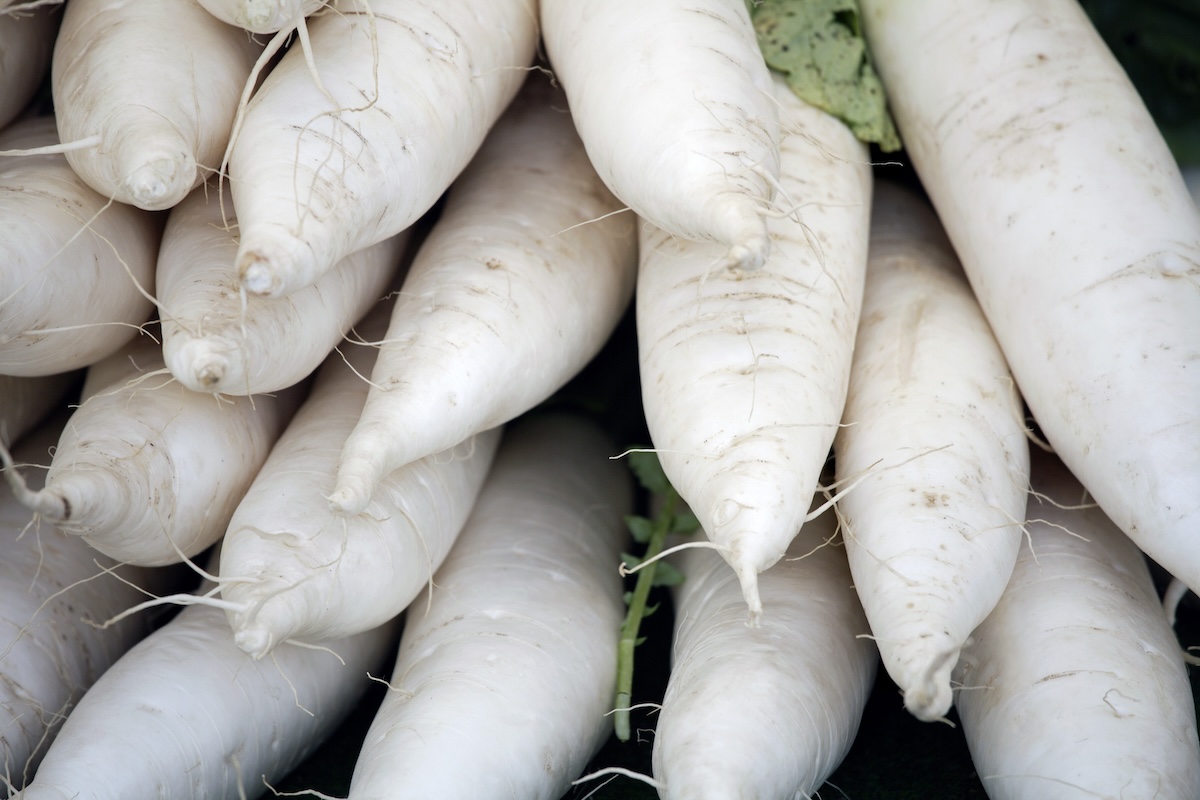What is horseradish? Although technically a perennial vegetable belonging to the brassica family, it is most often grown as an annual and used sparingly as a condiment. A little of it, after all, goes a long way! That is true in another sense as well, since horseradish plant is invasive and can canter beyond where it is supposed to be.
Therefore, when considering how to grow horseradish, you’ll want to take steps to corral it before it gets out of hand. Although the horseradish growing zone theoretically extends from USDA Zones 2 through 9, the plant prefers cool conditions.
Growing Horseradish at a Glance
Common Name: Horseradish
Scientific Name: Armoracia rusticana
Hardiness Zone: 2-9
Soil: Rich, deep
Light: Full or partial sun
Water: Medium
Food: Compost or low nitrogen fertilizer
Propagation: Root cuttings or seeds
Safety: Eye and skin irritant
Horseradish Characteristics
The wild horseradish plant originated in eastern Europe and western Asia, possibly deriving its common name from the German meerrettich, which actually means “sea radish.” “Meer” could have slurred into “mare,” with that equine moniker eventually being dropped in favor of plain “horse.”
The plant, which usually tops out at around 2 to 3 feet, has large, undulating leaves, which can grow up to 2 feet long and 6 inches across, resembling those of the plant dock.
Horseradish makes clusters of small four-petal white flowers in early to mid-summer. However, those often are snipped off so that all of the plant’s energy will go into producing yellow-white or white carrot-like roots that have a pungent, spicy flavor.
Recommended Horseradish Varieties
- ‘Maliner Kren’: Derived from the common type of horseradish, which is considered to have the best flavor, this variety grows to 2 feet high with wide, crinkled leaves.
- ‘Bohemian’: Also growing to 2 feet, the Bohemian type of horseradish reportedly doesn’t have as good a flavor as the common type, but does offer better disease resistance with its smoother, narrower foliage.
- ‘Variegata’: This variegated cultivar of common horseradish grows to 3 feet with white-splashed green leaves and adapts well to partial shade.
Planting Horseradish
Horseradish usually is grown from root cuttings called sets or thongs rather than from seedlings.
When is the best time to plant horseradish?
Plant horseradish root cuttings as early in the spring as you can work the ground, preferably late March or early April, since the crop requires a five-month growing season to mature by its harvest time in late autumn. Start horseradish seedlings in January or February so they will be large enough to set out in April.
Where can horseradish grow?
When planting horseradish, choose a location in full or partial sun which has deep, rich soil. If possible, confine the roots by placing them in a raised bed. Alternatively, you can create a small, confined bed underground by burying a bottomless 5-gallon bucket or a PVC pipe 1 foot in diameter and 2 feet deep. Keep in mind that companion planting horseradish with potatoes might help to help deter potato bugs.
How do you plant horseradish?
Loosen the soil to a depth of 8 to 10 inches before you do your planting, preferably digging in some compost and/or organic fertilizer as well.
- Make a 3 to 4-inch deep trench.
- Lay root cuttings at a 45 degree angle in that trench with their narrow ends down and their wider ends up, placing them 1 foot apart from each other.
- Cover the tops of the roots with 2 to 3 inches of soil.
Can you grow horseradish in containers?
If you prefer growing horseradish in containers that are above the ground rather than underground, just make sure that those containers are deep enough to allow plenty of room for the roots to grow. A half barrel should do or consider a 15-gallon pot that is 18 inches deep.
Watering Horseradish
As with most vegetables, horseradish plants prefer about 1 inch of water a week. During periods when there is no rainfall, you may have to provide the equivalent of that amount via irrigation. Just avoid overwatering horseradish plants, as that can cause their roots to rot. A 2-inch layer of mulch around the plants, composed of shredded dead leaves or compost, should help suppress weeds as well as maintain soil moisture for ideal horseradish cultivation.
Fertilizing Horseradish
Compost or composted manure should provide enough nutrients for your horseradish if you dig 1 inch of it into the soil before you plant your root cuttings. However, if you prefer, you also can add a low-nitrogen organic fertilizer such as 5-10-10, applying 2 to 3 pounds per 100 square feet. Avoid using fresh manure, which can cause overabundant foliage or forked roots in horseradish as well as possibly burning the plants.

Pruning Horseradish
Some growers prefer to remove the suckers on horseradish plants so that the remaining roots grow larger and straighter than they would otherwise. To perform this “stripping,” pull the dirt back from around the upper part of the roots when the plant is about 8 to 10 inches tall and rub or cut off all the small roots and the leafy suckers they produce from the sides and top of the plant, while not disturbing the largest central root or roots and its (or their) foliage. Push the soil back into place and repeat the stripping 6 weeks later.
Propagating Horseradish
As was previously mentioned, horseradish propagation usually is accomplished via sets, since rooting horseradish is not difficult. However, you can start plants from horseradish seed in mid to late winter, if you prefer.
Sow the seeds ¼- to ½-inch deep in damp and sterile seed-starting mix, keeping their containers at temperatures between 45 and 75 degrees Fahrenheit until those seeds germinate in one to two weeks. You then will need to keep the containers under a grow light, on a sunny windowsill, or in a greenhouse until the seedlings grow large enough to be transplanted outdoors.
Safety Considerations
Although horseradish is edible for humans, it will cause a burning sensation in your mouth. PennState Extension cautions that you should “prepare your horseradish in a well-ventilated area or even outside. It emits fumes that can make your nose run and irritate your eyes.” Since the plant also can be a skin irritant, it is a good idea to wear gloves and goggles when working with it.
As for your pets and livestock, the Utah State University Extension warns, “Do not feed animals horseradish. The volatile oils in the plant cause acute inflammation of the stomach and can be fatal.”
Potential Pests and Diseases
To control flea beetles, which can riddle horseradish foliage with small holes, cover the plants with floating row cover while they still are young. Make sure that the row cover is pinned down with soil on all sides so that the beetles can’t get in to lay their eggs on the plants.
Horseradish also can be infected by white rust, a fungal disease that causes white pustules on the undersides of the leaves. To prevent it, avoid growing horseradish where other brassicas have grown before. The Bohemian type reportedly is more resistant to that rust than the common type is.

Harvesting Horseradish
Although horseradish greens are edible, their flavor is described as bitter. The plant’s greens, in fact, are one of the foods consumed at Passover, when bitter herbs are eaten to represent the bitterness of the Israelites’ enslavement by Egyptians.
When is the best time to harvest horseradish?
As to when to harvest horseradish, you’ll want to do that in late autumn after frost has killed the foliage, preferably between late October and early November. If the roots aren’t large enough for a harvest at that time, leave them in the ground until early spring and harvest them before the plant begins making new foliage.
How do you harvest horseradish?
Wear gloves when “picking” horseradish, as it can irritate the skin.
- Dig up the roots using a shovel or spading fork.
- Use a knife or gardening shears to cut off the foliage 1 inch above the tops of the roots.
- If you intend to replant some of the smaller roots in spring, cut straight across the top of each one and make a slanting cut on the bottom, so you can tell which side should go up.
How do you store horseradish?
After scrubbing the roots with a vegetable brush and allowing them to dry, store them in a black perforated plastic bag in the vegetable drawer of your refrigerator for up to three months. Alternatively, place them in damp sand in a dark fruit cellar. (Light can cause the roots to turn green.) Grated horseradish must be stored in vinegar to preserve its flavor. Use 2 to 3 teaspoons of white wine vinegar per cup of horseradish.
Looking for more perennial vegetables? Check out our guides on growing asparagus, artichoke, and rhubarb.


